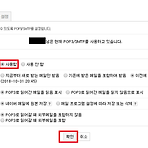[순열] 중복 없음 import itertools nums_a = [1, 2, 3] permu_a = itertools.permutations(nums_a, 2) 중복 import itertools nums_a = [1, 2, 3] permu = itertools.product(nums_a, repeat=2) [조합] 중복 없음 import itertools nums_a = [1, 2, 3] permu = itertools.combinations(nums_a, repeat=2) 중복 import itertools nums_a = [1, 2, 3] permu = itertools.combinations_with_replacement(nums_a, repeat=2)
 [edu] 파이썬 시작하기 - 이메일 보내기
[edu] 파이썬 시작하기 - 이메일 보내기
[Naver SMTP 설정] https://mail.naver.com/option/imap [gmail smtp 설정] 아래 주소로 접속 https://support.google.com/mail/answer/7104828?hl=ko&visit_id=636765832801774601-2011122225&rd=1 POP 설정을 먼저 한다. 빨간색 되있는 곳을 체크해 준다. gmail 자체 보안 레벨 때문에 보안수준을 낮은 앱 허용으로 변경 해주어야 한다. gmail smtp 설정이 완료되었다 [텍스트 보내기] import smtplib from email.mime.text import MIMEText me = '보내는사람' to_naver = '네이버 메일' to_gmail = '지메일' contents =..
[엑셀 쓰기] from openpyxl import Workbook import datetime wb = Workbook() ws = wb.active ws['A1'] = 42 ws.append([1, 2, 3]) ws['A3'] = datetime.datetime.now() wb.save("sample.xlsx") [엑셀 읽기] from openpyxl import Workbook from openpyxl import load_workbook wb = load_workbook(filename='sample.xlsx') name_sheet = 'Sheet' if name_sheet in wb: sheet = wb[name_sheet] multiple_cells = sheet['A1':'C3'] for r..
[파일쓰기] with open("data.txt", "w") as f: for i in range(10): data = "{} line!\n".format(i) f.write(data) [파일읽기] with open("data.txt", "r") as f: while True: line = f.readline() if not line: break print(line) 한줄씩 읽기 with open("data.txt", "r") as f: lines = f.readlines() for line in lines: print(line) 한번에 읽기
클로저는 일반 함수와 다르게, 자신(inner function)의 영역밖에서 호출된 함수의 변수값과 레퍼런스를 복사, 저장 접근을 가능하게 한다. def sort_priority(values, group): def helper(x): if x in group: return 0, x return 1, x values.sort(key=helper) numbers = [8, 33, 1, 2, 5, 4, 7, 6] group = {2, 3, 5, 7} sort_priority(numbers, group) print(numbers) sort_priority 의 동작은 group 이라는 집합에 포함되어 있으면 오름차순에서 우선순위를 준다. 멤버십 테스트를 통과 여부에 따라 0, 1의 가중치를 두어서 두그룹으로 분류..
[폰트사이즈18 고딕 진하게] workqueue 에 push 하고 pop 할때 마다 매번 다른 쓰레드로 동작 import threading import time def foo(t): i = 0 while True: print(threading.currentThread().getName(), i) i += 1 time.sleep(t) class WorkQueue: def __init__(self): self.works = list() def push(self, cb, *args, **kwargs): self.works.append((cb, args, kwargs)) def pop(self): if len(self.works): work, args, kwargs = self.works.pop(0) t = t..
[Thread] 폰트 사이즈 12 고딕 폰트 사이즈 12 고딕 폰트 사이즈 12 고딕 폰트 사이즈 12 고딕 폰트 사이즈 12 고딕 데몬쓰레드는 메인쓰레드가 종료되면 종료된다.import threading def sum(low, high): total = 0 for i in range(low, high): total += i print("sum=" + str(total)) t = threading.Thread(target=sum, args=(1, 100)) t.daemon = True t.start()
[Decorator: func] - 로그를 남길때 - 성능을 측정할 때 - 유저의 상태를 남기기 위한 redirect [performance.py] 일반 함수에 사용될 경우import time def stop_watch(func): def wrapper(*args, **kwargs): start = time.time() result = func(*args, **kwargs) print("{}: delay={}".format(func.__name__, time.time()-start)) return result return wrapper class 함수에 사용될 경우 인자 맨앞에 self 를 위치 시킨다.import time def stop_watch(func): def wrapper(self, *args..
[모듈 임포트] 소스 코드를 작성하다 보면 하나의 파일에 모든 것을 담을 수 없다. 기능별로 모듈화 해서 여러 파일에 저장하게 된다. 여러파일에 있는 모듈들을 임포트해서 사용해보자! zoo.py 에서 정의된 함수 find() 를 사용해 보자 def find(): print("find!") 다음과 같이 함수 하나를 정의했다. 이것을 root.py 에서 호출해보자 import zoo zoo.find() zoo 는 모듈이름(파일이름) 이고 해당 모듈에 있는 함수는 module.method 이렇게 호출하면된다. 모듈에 정의된 클래스는 어떻게 접근할까? class Animal: pass zoo.py 에 클래스를 정의하고 import zoo z = zoo.Animal() 함수와 마찬가지로 접근하면 된다. 예를 들어..
- Total
- Today
- Yesterday
- 장고
- virtualenv
- 모바일 스킨 적용
- 파이썬 독학
- 면접정답
- django chatbot
- 장고 카톡 자동응답
- 파이썬 입문
- GIT
- gitlab
- chatbot
- django
- Tistory
- Python
- 모바일 테마 적용
- pycrypto
- 장고 플러스친구 자동응답
- 면접답변
- 플러스친구 자동응답
- 이미지 비교
- 문과 코딩
- 문서 비교
- admin.py
- gitignore
- 파이썬
- 파이썬 프로그래밍
- 파이썬 강좌
- wsgi
- PuTTYGen
- 엑셀 비교
| 일 | 월 | 화 | 수 | 목 | 금 | 토 |
|---|---|---|---|---|---|---|
| 1 | 2 | 3 | 4 | 5 | 6 | |
| 7 | 8 | 9 | 10 | 11 | 12 | 13 |
| 14 | 15 | 16 | 17 | 18 | 19 | 20 |
| 21 | 22 | 23 | 24 | 25 | 26 | 27 |
| 28 | 29 | 30 |
